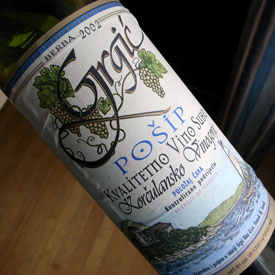I needed a drink Friday night, and despite the best efforts of the MBTA, I made my way to Casablanca restaurant in Harvard Square for small plates and wine. I spied a familiar name on the list and ordered up a 2006 Napa Fume Blanc from Grgich Hills. It hit the spot, crisp and dry, pineapply and cold, and took me back on a peculiar journey of oenophilic synchronicity.
Back In 2004, I took a summer vacation to Italy and Croatia. Two weeks of incredible eating and drinking. Towards the end of the trip, I was in Split, from where I took a ferry trip to several Dalmatian islands, including Vis, which was billed as, “vineyard island Vis.” How cool an idea is that? On Vis, I tasted several local wines with names I could neither pronounce or remember, which is a shame. Back in Split, I popped into a wine shop to find something to bring back. The shopkeeper pointed me towards a bottle of Grgić Pošip 2002 with the instruction that it was good with fish. It was from Korčula, an island I did not visit, but it was dry and delicious. With fish.
Flash forward a couple of years, and I’m in San Francisco on business. Which of course means I’m dragging my hapless but not unwilling colleague to Napa for an afternoon. We visited a handful of wineries, large and small, and then happened upon Grgich Hills. Could it be the same as Grgić? How could it be, but on the other hand, how could it not? (I didn’t notice it then, but the red and white checkered shield of Croatia is on the Grgich HIlls label) They didn’t have any Pošip, but my colleague brought back some of their famous Chardonnay. It turns out that the two winemakers are connected, but not in the way I would have guessed.


The Grgic(h) story starts in Croatia (Yugoslavia, actually), with Miljenko Grgich born into a winemaking family and fleeing communism in the ’50s for West Germany, Canada and then California. Later known as Mike, Grgich worked with several illustrious California winemakers and eventually partnered with Austin Hills to form Grgich Hills Cellar in 1977. It’s not a place, it’s two names. The story returns to Croatia only in 1996 when Mike goes back to set up Grgić Vina to combine local Croatian grapes (which Mike has proven are the ancestors of modern California Zinfandel) and high-tech techniques learned in Napa. You can read the full story at the Grgich Hills Estate web site, it’s quite a capsule history of California Chardonnay.
I still don’t know much about the spelling disparity or where to get more Grgić Pošip, but I’m happy to be reconnected with the Grgich family, and will definitely be stocking more Grgich Fume Blanc if I can get my hands on it.

Funny… the evening at Casablanca, for me too, brought back fond memories of other experiences… but didn’t really warrant any musings about the food.
I have been to both Grgic Vina in Croatia and Grgich Hills in Napa, and both make exceptionally fine wines. While I like the article in general, as I am of Croatian descent, I am compelled to make a couple of clarifications. First, Croatia is not “Yugoslavia, actually.” Croatia became independent from the former Yugoslavia in 1992, and Yugoslavia broke up soon thereafter. Parts of Serbia still refer to themselves as Yugoslavian, but as a country, it no longer exists. Regarding the author’s question about the spelling discrepancy (Grgic vs. Grgich): In the Croatian spelling, the accent over the c (in Grgic) means it is pronounced as a “ch”. Mike Grgich, as most Croatians did when they emigrated to America, Anglicized his name and added the “h” Zivio!! (Cheers!!)
Thanks Karen. I’ve been fortunate enough to visit Croatia and would never confuse it for Yugoslavia, but I said that the story started in Yugoslavia because that state existed at the time of Mike Grgich’s birth and subsequent emigration. As the Grgich Hills website has it, “Mike was miserable, though, under communist rule in Yugoslavia. So, in 1954 in search of freedom, he fled to West Germany and then made his way to Canada.”